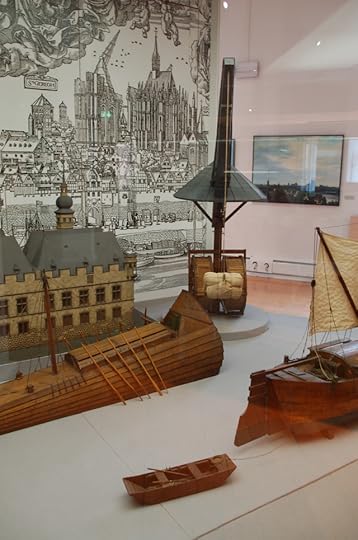E.C. Ambrose's Blog, page 5
February 7, 2017
Elisha Mancer Launch Day! With footnotes. . .
Elisha Mancer, Book 4 of The Dark Apostle, is now available in bookstores everywhere! And you can find sample chapters for this, and all of the books in the series, at TheDarkApostle.com When you love it, you can click through and buy the book.
[image error]
cover of Elisha Mancer, by the amazing Cliff Nielsen
As you may know, this blog exists in part to serve as the footnotes and research comments for my historical fantasy novels. Herewith, are the “notes” for this volume. I don’t think any of them contain direct spoilers, but they do serve as some indicators of the historical goodies that influence the plot. If you are concerned about spoilers, you may wish to go read the book, then return here for more juicy details.
I hope you enjoy this introduction to the settings, characters and events from history that find their way into Elisha Mancer.
This book takes place all over Europe, including Heidelberg and Trier, Germany. With references to some cool medieval technology like the Kranen, and a visit to one of Bavaria’s salt mines. There’s also a stop in Koln, to visit the Bones of the Magi because, let’s face it, I couldn’t pass that up. But there was at least one great city, Aachen, I planned to use and never did.
My visit to Aachen did help me to learn more about the Holy Roman Empire, and its two emperors during my period, Charles IV and Louis the Bavarian (whom I have called Ludwig to distinguish him from the numerous other Louis in the area. . .) Succession was often a problem, and not always, as many believe, based on primogeniture.
This book also introduces one of the Great Characters of the Middle Ages, Cola Di Rienzo, the madman who ruled Rome.
He could rule Rome because the pope wasn’t there–but kept planning to return. The church retained a lot of power, internationally, and at its heart in Rome itself, due, in large measure, to the holy relics found there.
and this volume brings 1347 to a close, with a world-tour you may already be expecting. But there is still one more volume to go. . .


January 28, 2017
Health Insurance, Medieval Style
Many people in the US right now are concerned about their health insurance (among other things). Will it change all over again? Probably–won’t it be fun to find out. We tend to think of insurance as a recent innovation, a social good offered to citizens for commercial purposes, generally through an employer, and designed to offer peace of mind in the event of a health emergency. However, this and many other benefits were available to medieval tradesmen and merchants through their local guild.
[image error]
This tower in the London wall once served as the operating theater for the Company of Barber-surgeons
The guild system managed a wide variety of aspects of business during the middle ages. They developed during the 12th century in Europe, from the tendency of people in a given trade to have similar concerns, and band together to address them.
Depending on the trade served by the guild, they might offer the equivalent of today’s professional societies–the networking, mutual support and lead generation, not to mention the camaraderie of joining together with like minds. They helped apprentices find masters and journeymen find work, not to mention conferring the honors for those at the top of the profession–maintaining professional standards. They also offered funeral and survivorship benefits for widows and children, like many trade unions do today. Although I am not sure any union puts up dowries for the daughters of their poorer members.
In addition to services for members, guilds often performed charitable work and public service, like the famous Goldsmiths’ Guild celebration of the 15th century, which included mechanized angels blowing on trumpets to announce the procession.
Health insurance could mean payments to barbers, surgeons or physicians as needed on behalf of the ill or injured guild member, or direct payments to the member during a time when they were unable to work. The protagonist of my series, Elisha Barber, would have been a member of the Worshipful Company of Barbers, founded in 1308 in London, and his brother, Nathaniel, a member of the Tinsmith’s guild. Each guild had a charter spelling out the duties and benefits for members, and might specify payments for particular injuries, often relating to the profession at hand. The dues paid by the members went to support the services they received.
While modern-day people often decry any significant change as a return to the middle ages, in some ways, they really weren’t so bad. . .
[image error]
The Merchant-Adventurers’ Guild Hall, York, England


January 20, 2017
What Comes Next? Power Transitions in the Middle Ages
Today is a big day in America, yet it’s an event that occurs every four or eight years: the inauguration of a new president. Since I’ve also been listening to the Hamilton soundtrack, by Lin-Manuel Miranda, the words of King George’s songs keep running through my head.
“What comes next/ you’ve been freed/ Do you know how hard it is to lead?”
and later on, “Are they gonna keep replacing whoever’s in charge?”
[image error]
Charles IV, King of Bohemia, and Holy Roman Emperor, 1346-1378
I thought I would mark the occasion with some observations about the transfer of power in the Middle Ages. People often assume, and fantasy authors usually present, a medieval world in which leadership roles transferred somewhat automatically from father to son. In the event that there was no son, some amount of chaos ensued while the potential heirs presented their competing claims–often at the end of a sword.
Edward III of England, for example, claimed the throne of France through his mother, and fought for it numerous times. Such a claim was often made not to actually seize the throne of another country, but rather to serve as a club with which to gain other concessions, like ancestral lands or privileges once belonging to the family. By that point, in the 1340’s, the ancestry of both England and France were so tangled through centuries of intermarriage that each monarch laid claim to the throne or fealty of the other.
In some places, the sons of a leader were deliberately overlooked, because you couldn’t be certain they were actually related to him. In that case, the children of the lord’s sister would be his heirs. (Ghana, for example)
At other times on this blog, I’ve noted different forms of transitioning power, some of which are less familiar to the reader of medieval fantasy, or to others more casually aware of the Middle Ages. Mongolia’s democratic leanings, for instance, are a common feature of nomadic cultures. Leadership claims tended to be more based on vital real-world skills like an ability to read the weather or land, to lead toward good hunting or good pastureland, to negotiate for passage or retaliate quickly for the incursions of others. The idea of owning land and building permanent structures which might need a more permanent managerial system, anthropologically speaking, seems to arise more with the advent of agriculture rather than husbandry.
The title of Holy Roman Emperor was also by election, with the electors representing different regions of the empire (what is now Germany and Eastern Europe) as well as high-ranking church officials. In the event that an emperor was found to be unsuitable, the electors then put forward a new candidate–whose first task, of course, was to convince the sitting emperor to give up his crown.
Even within the settled structures of medieval culture, the city-states of Italy often used communal governance, with a group of high-ranking officials taking charge and making decisions for their city and region. Again, the economy of these city-states plays a large role in determining their governance: their trade-based wealth required leadership drawn from those who understood the balances of import and export, investment and tariff. And of course, those who wield significant wealth and influence often refuse to submit to mere political authority, preferring to hold the reins themselves.
Rome always held a unique position among the cities of Italy. The theoretical seat of the church, it derived much of its prominence from the presence of the Pope and cardinals–but they fled to France when the countryside got rough, leaving the barons to squabble over the city itself. Cola di Rienzo led a popular revolt to claim control of the city, only to (as Hamilton‘s King George would have predicted) fall into anarchy when he couldn’t figure out how to lead a state instead of an army.
And even within the traditional feudal system of transference of power to family, we have cases where women inherited, like Joanna of Naples, or governed on behalf of absent husbands or minor children, often remaining in power for a long time–as happened more than once in China.
So, will America’s transition of power lead to a new age of glory, or to a devolution into chaos, or, as seems more likely, be simply another term of checks and balances until we peacefully (if with protest) transition again? Hopefully no one will need to get killed at the gate for us to find out.


January 13, 2017
Celebrating Friday the 13th with the Knights Templar!
So, today is Friday the Thirteenth, a day which apparently over 21 million Americans still fear. There are numerous explanations for this concern about the date (I actually wrote a paper about this back in junior high, when I was obsessed with superstitions). The number thirteen is widely considered unlucky in Europe–hence the term trisksadekaphobic (for someone afraid of that number), and in France, the position of the quatorzieme, or professional fourteenth guest, who would round out your party numbers if the guest list proved unlucky.
But it is the persecution of the Knights Templar that usually gets the credit for the link of that unlucky number with Friday. When I started out writing the Dark Apostle books, I quickly grew frustrated with trying to find references at the local bookstores. The Templars were a hot topic (ha, ha, I know) and the Medieval History shelves were entirely dominated by books about Templars. I swore I would not write about them.
[image error]
tomb effigies in the former Knights Templar Chapel in London
Then the idea for The Grail Maiden came along. I wanted to write about the historical hinge point from which my timeline of the British monarchy departed, the death of Edward I (Edward Longshanks) in July of 1307. He was ill, and near the Scottish border involved in his attempts to subdue the Scots. In my timeline, I have his son, Edward II, die shortly afterward, leaving the throne vacant, and available for a side-long claimant–which is another story.
So when I followed my usual process and started searching for other things that happened in 1307 and might have an impact on the story I had in mind–involving Duke Randall and his wife Allyson, I discovered that the arrests of the Templars in France began on October 13, 1307, a fact too interesting to avoid.
Founded in 1119 by a French nobleman during the First Crusade, the Templars were originally charged with defending pilgrims on their way to the holy sites in Jerusalem, then as now a highly contentious region. Knights took an oath of poverty, which meant many of them donated their moneys and estates to the Order, and the Templars as a whole began to accumulate an unseemly amount of wealth. Because of their noble character, wide-spread centers and martial discipline, the Templars quickly assumed other roles: most notably, serving as bankers for nobles on the move, or those who needed funds for various wars and projects.
Enter King Phillip of France, AKA, Phillip the Fair. Phillip was already unhappy because the Templars stated a desire to found their own nation (ala the state of Prussia, founded by the Teutonic Knights), and they planned to stake their claim in the Languedoc region of France. Also, like many of the nobles, Phillip was already in debt to the Templars, and it might be awfully convenient not to have to pay back that debt.
Phillip accused the Templars of heresy: spitting on the cross; kissing the lips, navel and posterior of the initiate; and idol-worship, among others. The 138 arrested knights were tortured to elicit confessions of these charges (most of them confessed to at least one of the carges), and some of them were put to death, most notably by burning at the stake.
If you are interested in my fictional take on some of this history, The Grail Maiden is currently on sale as part of this multi-author 99-cent sale, which runs through January 14th. How’s that for a TGIF?
[image error]


January 7, 2017
“Rogue One” and the Challenge of Prequels
Okay, if you have not yet seen “Rogue One: A Star Wars Story,” now would be a good time. Don’t worry, I’ll wait. Unless you don’t mind about spoilers, in which case come on in!
[image error]
one of the promotional images Lucasfilm created for Rogue One: A Star Wars Story
“Rogue One” is an interesting solution to the problems of prequels. I’ve written a couple of prequel stories myself, most notably “The Burning,” which takes place when Elisha is a boy, just after the witch’s burning that changes the course of his life; and The Grail Maiden, a novella about the early relationships of Duke Randall, his wife Allyson, and their good friend, Lord Robert.
In order to develop a prequel, the author must first find a hook for a new story. The hooks tend to be most successful when they explore an area that fans will be curious about. That could be the origin of a key character or plot point in the original work, or something related to the original, but not necessarily germane to its essence. So, “Rogue One” takes up the question of how the rebels got the Death Star plans (germane), while The Grail Maiden looks into the history of some secondary characters (not germane). Hopefully, this material will enhance readers’ interest in the series, but it won’t necessarily inform their understanding of the plot.
Two, the prequel has to be in keeping with the audience’s knowledge of the world from their exposure to the principal work. The ideal sequel will give them new things to think about, a new insight into characters or background.
A key aspect of this fidelity to the source material is how the prequel ends. In my story, readers familiar with Elisha Barber would know how the protagonists of the prequel fit in. Their enjoyment of the story comes from discovering things they didn’t know about those protagonists, and the tension arises from the secrets revealed there. How did these people, with this set of relationships, become the characters we’ve already met?
“Rogue One” had a different challenge, because none of the protagonists for this film appears in any other place. Thus the audience is set up to expect a tragedy. Either all of these characters dies, or some other huge event causes them to be thrust outside the rebellion they are risking their lives for. That can make it hard to maintain suspense because the ending is pretty clear from what we already know of the original work. In this case, they had fun with introducing a number of minor characters from the original, expanding the roles for some of them, or simply offering cameos to some fringe personalities. They also had the challenge of pulling off the necessary Hollywood upbeat ending, given the fate of the protagonists, after doing the work of making us root for them.
It occurs to me that the film “Memento” is a series of prequel scenes, each one shedding light on the scene you’ve just viewed, creating a story that is told backwards. It builds tension in a similar way to other prequels–by setting up a dis-junction between the present of the narrative world, and its past. The audience wants to see that tension resolved, and, as “Memento” shows, that tension can be very powerful indeed.
In the more usual meaning, a prequel is a complete stand-alone work created after the primary work, but place before it in the narrative timeline. A prequel is more or less a gift for the fans. Sometimes, people ask if they should read the books in order of publication, or in the chronological order of the series events. The prequels are generally much more rewarding for people who already know the milieu and will have an investment in the sort of details that a prequel illuminates in a world they already love. They can be used as an introduction to a series, but will lack some of the resonance endowed by the things the dedicated reader already knows.
In honor of prequelitis, The Grail Maiden is currently on sale for only 99 cents at Amazon and through Smashwords.


December 16, 2016
Guest Author: Kathryn Hills Talks about Haunting Highland House
Since I am visiting with my agent and editors this week, I asked my friend Kathryn Hills to stop in and talk about the history and fantasy behind her novel, Haunting Highland House, a spicy fantasy romance released by The Wild Rose Press in October. Besides, it’s winter–time to turn up the heat!
The cover of Haunting Highland House, by Kathryn Hills
What was the inception of your most recent project? What were your first steps in building that idea into a viable story?
I’ve always been fascinated by ghost stories, but I never expected to write one. Yet seven years ago, I visited a restored Victorian mansion on Cape Cod and came up with the idea for Haunting Highland House. A bit like being struck by lightning, I was stunned by the story unfolding in my head during the long drive home. I was not a writer, you see, but I became filled with ideas for a book. My imagination swirled around the old mansion, the grand estate it had once been part of, and the turbulent past it suffered as it fell into ruin. These thoughts spurred me on… What would it be like to visit the estate when it was thriving, the late 1800’s? As a “modern person,” what would it be like to be thrust back in time to see the place and meet the people who lived then? And if I went there, could I get back?
How did all this “wondering” and “imagining” lead to connecting ghosts with time travel? In my fictional world, meeting a time traveler is a paranormal experience. Something beyond the scope of normal scientific understanding. No stretch there. But since my absolute favorite paranormal things in my life are ghosts and haunting experiences I melded the two. I’ve been a ghost hunter for years and love the idea of detached spirits or nonphysical entities being unhindered time travelers. After all, what is the past, present, and future to a ghost? Likely something completely different than it is for us. Time is probably different, too. Wouldn’t it be fun if we could travel to “when” we choose and come back, perhaps like a time-traveling ghost? Or someone living with a magical tool to help do it?
& 3. What kind of research and/or world-building did you do before beginning? AND How does the real world affect your speculative fiction?
Researching ghosts and time travel is a bit like following Alice’s rabbit down a worm hole wearing a tin foil hat. You never quite know where you’ll end up, and there are many theories, none proven. As a result, I chose to invent my own time travel “rules.” (I’m not into spoilers, so you’ll have to read the book if you want to learn more) Once that sticky bit was addressed, I focused on the actual history surrounding the estate and the time period. Wealthy Bostonians, American Victorian society, evolving social customs, clothing, technology, and physical travel such as by coach, train, and passenger steamer. The last led me to research shipwrecks as one plays a large part in Haunting Highland House. I’ve amassed a library studying these things and more for the series.
As this story is paranormal/fantasy romance, I’ve also researched psychic mediums and the rise of spiritualism during the Victorian era, magic, and folklore. All of them are vital to The Time Traveler’s Journey series, and I freely admit I find such topics fascinating. Discussing them with paranormal investigators, psychics, a shaman, and even an illusionist are all delightful perks of being a writer.
If I could choose a few descriptors that would go in a blurb on the cover…
One line from this first book… Time is but a destination.
Where should readers go to find out more about my work?
https://www.facebook.com/AuthorKathrynHills/
https://twitter.com/AuthorKathrynH
https://www.amazon.com/Kathryn-Hills/e/B01LBDCVVU
https://www.youtube.com/watch?v=yHKO-9pgdQE&feature=youtu.be
Link to something amazing…
Following is the link to the place that inspired Haunting Highland House. Its real name is Highfield Hall, located in Falmouth, MA on Cape Cod. You can learn its history, including the amazing journey from ruin to restoration, and see the mansion as it thrives today. Perhaps even visit if you’re in the northeast.
http://highfieldhallandgardens.org/about-us/
About Kathryn
The rich history and many mysteries of New England are the perfect backdrop for Kathryn’s books. Winding roads lined by old stone walls, forgotten cemeteries, grand homes with shadowy pasts…all sparks for her imagination. Whether it’s a quaint seaside town or the vibrant city of Boston, it’s easy for this “hauntingly romantic” author to envision the past mingling with the present.
Taking it further – to have characters experience the past and present, opposite to “when” they belong – is the fun part. No surprise, some of Kathryn’s favorite stories involve time travel. And ghosts! Sprinkle in some magic, and you’re off on a great adventure!
When not writing, she’s taking photographs of the beautiful landscape that surrounds her. Kathryn shares her colonial home with those she loves most…her wonderful husband and daughter, and four crazy dogs.


December 9, 2016
Medieval Technology: the crane
One of the niftiest things I saw in Germany while I was doing research for Elisha Mancer were the Kranen of Trier–the medieval cranes used to unload boats on the nearby Mosel River. I was fascinated by these curious round towers on the riverside. The wear pattern around the mooring rings indicated many years of use–boats tying up to make use of the cranes.
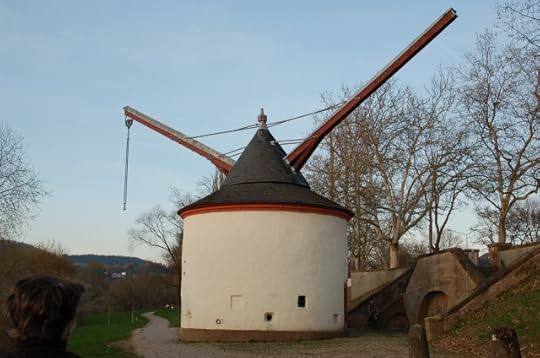
a crane at Trier dating to 1413
Like a windmill, the top of the crane can rotate to aim the lift arm more effectively and guide the crates from the boat to the shore. Inside the crane is a huge wooden wheel apparatus that operates the pulleys and rotates the arm. The crane is human-powered: like a giant hamster wheel. The technical term for these cranes is the Treadwheel Crane. Wikipedia has some cool images from art and illuminations, as well as reconstructions of treadwheel cranes from the Roman era.
Small windows in the base allow for communication and visual confirmation with the operators. Yes, these cranes have two wheels to allow for faster unloading with two people working at once.
One of my frustrations with pseudo-medieval fantasy is that they often feature technologically stagnant societies, as if human ingenuity would simply cease with access to magic. Now, there are some books in which magic can, apparently, do anything without limits or costs (a trope which irritates me no end), but in most cases, the magic is limited to certain individuals or certain kinds of tasks, and clearly has a higher cost than simply having ordinary mortals doing their jobs. And, as mortals, do, seeking ways to make their jobs easier.


December 2, 2016
Medieval Scenes and Settings: Heidelberg, Germany
When the Christmas season rolls around, Germany comes to mind. I think this is due to the visual influence of medieval architecture on so many of the villages and ideas we associate with Christmas, with the German carol ‘Stille Nacht’ (one of the few carols you often hear in a different language), and, of course, the strong associations of snow and pine trees. Germany is also the birthplace of the Christmas tree.
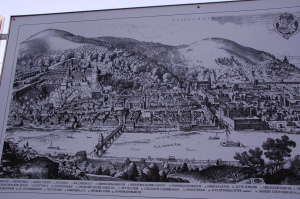
17th century version of the map of Heidelberg
One of my favorite German cities is Heidelberg, a university town on the Neckar river in south-eastern Germany. People have been living there for hundreds of thousands of years, as evidenced by the jawbone of “Heidelberg Man” found nearby in 1907. It was established as a town by the Romans, who were subsequently chased off by the Germanic hill tribes in the third century AD.

View of Heidelberg Castle from across the river
I first went there as a child on a trip with my parents, and fell in love with the castle that dominates the city. An intimidating red stone structure at the top of the hill, it must be one of the most beautiful ruins in Europe–but parts of it have been restored, and now house, among other things, an apothecary museum and an extremely large wine cask or “tun.”
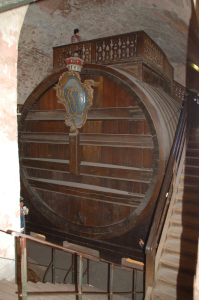
the giant tun, with a capacity around 57,000 gallons
So much historical character remains in the streets and buildings, that it is like stepping back in time. You will not be surprised to find that Heidelberg is one of the key settings in the next Dark Apostle book, Elisha Mancer.
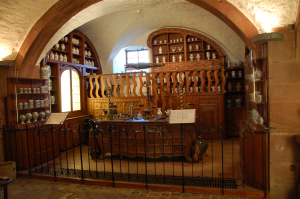
reconstructed early modern apothecary shop in the museum
In addition to the outstanding castle, Heidelberg contains striking bridges, and the austerely magnificent Church of the Holy Ghost, which was under construction during Elisha’s time, the 1340’s. Heidelberg was also, at that time, home to a thriving Jewish community, and later served as a refuge during the persecutions that accompanied the Black Death.
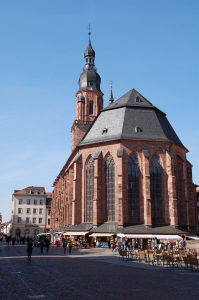
Church of the Holy Spirit


November 22, 2016
E. C. Ambrose Takes the Fun out of Movies: “Fantastic Beasts” and the Ethics of Magic
This weekend, I went to see the new Potterverse film, “Fantastic Creatures and Where to Find Them.” Let me preface these remarks by saying that I love a good fantasy creature, but I have some issues with Rowling’s work overall (from the writerly perspective) so while I have read the Potter books, I would not describe myself as a fan. So, as I wrote this blog, I realized it has a certain kinship with my entry on Bilbo Baggins’ Bathrobe in its examination of aspects of worldbuilding that the author and filmmakers probably did not intend to present–and a new blog series was born! If you don’t want me to take the fun out of this movie by making you think about it in a different light, perhaps it’s best not to read any further.
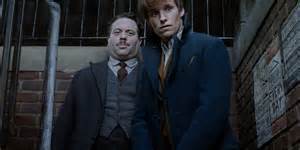
Newt Scamander and his muggle sidekick, Jacob
This film was thoroughly entertaining for the first two-thirds or so, with Newt’s interactions with and devotion to the Fantastic Beasts of the title. As it reached the climax, it got me to thinking about the nature of Rowling’s Wizarding World as portrayed in the books, and now in this film. There are enough witches and wizards to have entirely separate governments, bureaucracies, banks, and shopping districts–apparently around the world. And, aside from needing proper training to use the hereditary gift of magic (there are occasional wizards born to muggle families–apparently a mutation of some sort?), there is basically no cost or limitation on what they can do.
In the books, of course, you get a more nuanced perspective on this, but not greatly so. The books tend to introduce magic because it’s fun and solves a problem, but without extrapolating either the consequences of the problem, or of the magic used to solve it. So when Harry breaks his arm during a quidditch match, and his bones are accidentally dissolved, they are re-grown again at the cost of some pain and a fairly brief recovery time, to be completely normal. I always wondered, what happened to the muscles and tendons which were attached to the bone in the meantime? Apparently, they were all just fine. But I digress.
In the film, we are presented with the large and well-organized Macusa, the magical congress of the United States (apparently rhymes with “Yakuza”: coincidence?). They are capable of repairing huge swaths of damage in a very short time using waves of their wands, so that the structures are as good as new. They can then obliviate any non-magical persons who might have witnessed the magic, leaving them all perfectly normal. Again, all of this at no apparent cost, with no apparent difficulty. They have strict laws to keep themselves apart from the muggles (no-majs in the new parlance). Naturally, the protagonists have a token muggle friend, but they do eventually comply with the laws.
I would like to contrast two meal scenes in the film, to illustrate my concern with this structure of magical society. In one, a muggle woman, leader of an anti-witch movement called Second Salem, feeds dozens of children in exchange for their distribution of her leaflets. In order to make the meal, this woman and her family presumably had to work for the money or to seek out charitable contributions. They then had to work to produce the meal in order to feed so many people. Their kitchen, indeed their home, is dark, gloomy and poorly furnished, but they manage to feed all of these children, at least once a day.
In another scene, American witch Tina takes home the protagonist Newt Scamander and his muggle acquaintance, Jacob. There, her washing dries on magical racks. Her table sets itself with beautiful details like soaring napkins, in a cozy and rather luxurious apartment. Her sister whips up a meal in moments, apparently from nothing, all the way down to a freshly cooked and delicious apple strudel. The place is bright, airy, comfortable, the food is excellent, provided with no labor at all. The sisters do have jobs at the Congress, though I don’t have a clear idea of how their work puts food on the table in a literal sense. Work seems to be unnecessary at least as far as daily needs and wants are concerned. (Tina’s earlier demotion seems to have had no effect on her standard of living, only on her sense of self.)
Here we have a large group of people with extraordinary resources that cost them, so far as we can tell, absolutely nothing. What if Superman never used his powers to try to save anyone (except from trouble he created)? What if he just lived as Clark Kent, and went home everyday to fly around his apartment and use his x-ray vision for, well, other purposes? Would he still be considered a hero? How about a whole society of supermen who use their power only for their own benefit, who have such an excess of power that they can use it for every trivial purpose?
Is the philosophy of the Wizarding World that muggles need to pull themselves up, to make their own way in the world? If so, it is a surprisingly pervasive philosophy–are renegade witches ever arrested for running magical soup kitchens for muggles because they feel they’d like to use their powers for the good of others? Do witches infiltrate and guide search-and-rescue teams to injured muggles, or work as nurses where they secretly prompt better healing than the muggles might otherwise have? What about in cases where the injury is magically caused or a result of wizardly dueling?
I am not sure you can cause that much destruction to Times Square without anyone getting injured, and simply making them forget exactly how they got hurt, then abandoning them in a perfectly repaired city seems like a recipe for a psychological breakdown. But the Wizarding World is not concerned with any of this, and even the man whose son is killed seemingly walks away without explanation. I wondered why, given all of their power, the wizards aren’t just running the country, whether overtly or covertly.
It is implied that the villain of the new film series, Gellert Grindelwald, intends to spark war with the muggles. This seems rather pointless. If he wants to rule the world, or just America, all he has to do is run for president. When you can coerce or bribe people with unlimited wealth (or unlimited threats), and even make them forget they’ve been influenced–there’s really no end to the potential abuses of power. Second, why would a muggle war be remotely threatening to the Wizarding World? I have trouble conceiving of any way that the muggles could fight back: they might have superior numbers, but they’d still be building weapons and directing troops while the wizards would be appirating and firebombing with a flick of their wands. The wizards, as enemy combatants, would be akin to Isis sleeper cells, but with completely invisible modes of travel, communication and weaponry–only there seem to be many, many more wizards and they are much more organized.
((as an aside, it is implied that Newt and/or his brother, fought in World War I, but I don’t know why the wizards would have been involved, or how. If they either aid or infiltrate muggle society as soldiers, why not as policemen, doctors or psychiatrists? and wouldn’t they have more effective ways of preventing conflict–hello, time-turner?))
Spiderman lives with the ethos he learned from his family: with great power, comes great responsibility. And Spiderman is a limited resource–he’s the only one who can do what he does, he can’t be in many places at once. In the Wizarding World, the only responsibility seems to be “clean up your mess, and obliviate the witnesses.”


November 11, 2016
A Queen for our time? Joanna of Naples, Great Characters of the Middle Ages
This is the latest installment in my Great Characters of the Middle Ages series. Some of these folks are people who are appearing my my work. Joanna, alas, I must set aside–though I am tempted to post some of the scenes in which she originally appeared, that work was set aside when we developed the new series outline, and alas, Joanna no longer appears.
When I started researching the people of the 14th century who might relate to my Dark Apostle series, a few immediately leapt from the history books and demanded to be included. Cola di Rienzo, the madman who ruled Rome was one of them, and Joanna was the other. She was married four times and sold Avignon to the pope, but I’m getting ahead of myself.
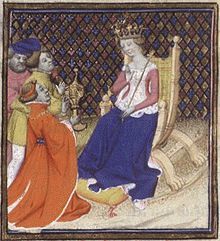 Born in 1328, Joanna acceded to the throne of Naples on the death of her father, King Robert, in 1343–yes, she was only fifteen years old. Like many teens of the era, she was already married, to Andrew of Hungary, who was not mentioned in the king’s will, even as her consort. Almost immediately, the succession was challenged on all sides by the king’s brothers. Andrew was crowned at her side in 1344, but shut out of any role in the government, and almost immediately began to fight for his part–and to fear for his life.
Born in 1328, Joanna acceded to the throne of Naples on the death of her father, King Robert, in 1343–yes, she was only fifteen years old. Like many teens of the era, she was already married, to Andrew of Hungary, who was not mentioned in the king’s will, even as her consort. Almost immediately, the succession was challenged on all sides by the king’s brothers. Andrew was crowned at her side in 1344, but shut out of any role in the government, and almost immediately began to fight for his part–and to fear for his life.
His fear would prove to be justified. One night during a hunting expedition in 1345, Andrew was lured from his room and a servant barred the door after him. He was then attacked, strangled and tossed out a window with a rope around his genitals. Suspicion immediately fell upon Joanna who was in her own room at the time, and controversy raged. One of her most ardent defenders was the poet Boccaccio, who included her in his Lives of Famous Women. To this day, her complicity in the murder has not been established. She gave birth to a son, who died at the age of two in care of his Hungarian relatives.
Andrew’s brother, the king of Hungary, was convinced after she declined to marry the dead man’s younger brother, and marched on Italy. Joanna’s second husband, her cousin Louis of Tarranto, successfully repelled one of his rivals, and they secured a treaty with Sicily to stand against Hungary’s invasion. But she hadn’t sought the appropriate papal dispensation to marry her cousin, and the marriage was widely unpopular. When the Hungarian army reached Naples in early 1348, Joanna fled to her holdings in France. At Avignon, she reconciled with the Pope and transferred the city to him.
Together, Joanna and Louis returned to Naples where they expanded their territory. The couple had two children, both of whom died young. Louis caught cold and died in 1362. It’s hard to say if Joanna missed Louis–certainly his martial disposition brought them a number of victories, but the evidence suggests she had a highly independent spirit and likely chafed under his demands. So his death gave her the opportunity to rule in her own stead, but she still required a husband, ideally to both conceive an heir, and also to cement her position.
Her new husband, younger by ten years, was James IV of Majorca–who had been driven mad by being imprisoned in an iron cage for fourteen years at the hands of his uncle King Peter of Aragon. So, yeah, not a very promising beginning. He did make some attempts to behave in a kingly fashion–to the perturbation of his wife, who really didn’t want someone else to take power in Naples. This strife sent him back to Spain in 1366 where he remained, save one brief return, until his death (perhaps from poison) in 1375.
Still without an heir and desperate to have a bulwark against her predatory relatives, in 1376, at the age of 48, Joanna married Otto, Duke of Brunswick-Grubenhagen, who did his best–but the marriage only irritated Charles of Durazzo, who had been scheming to take power for many years. He allied with her old enemy the king of Hungary, and even her long-standing ties with the papal court frayed to naught during the Great Schism, when she supported the wrong pope. The pope at Rome, Urban IV, supported her enemies and she was declared a heretic and her lands forfeit.
Joanna named an heir from among her cousins who supported her rights, but by then it was rather too late. Charles of Durazzo invaded at the head of a Hungarian army, and Joanna’s few soldiers, under Otto’s command, could not repel them. Charles seized Joanna, and had her killed in 1382, though he would claim the death was due to natural causes.
When people wonder how I can spend so much time researching history, I need only to tell them Joanna’s story–a little-known figure whose life, all by itself, would make a great novel.




